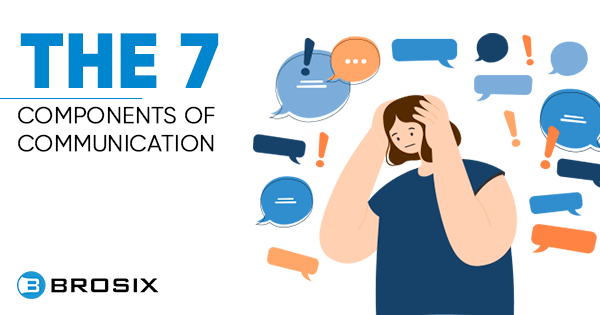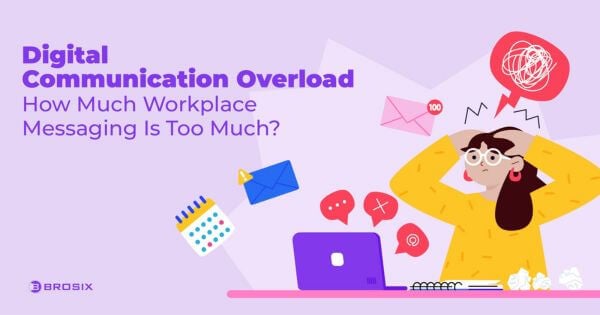Effective workplace communication is very important, no matter what sort of business you’re running, as it affects all areas of the company. It’s critical to ensure that every message is relayed clearly and that all workers are always well-informed about any new contracts/changes to the project, etc.
Achieving this can often be tricky, especially if you manage workers with highly different personality types; however, with time and practice, you should be able to implement effective communication tools.
The goal of this article is to help you with that – let’s take a look at the most important components of effective communication in the workplace (and in general).
What, exactly, is effective communication?
When it comes to an office/workplace setting, effective communication can be described as the process of exchanging information between various members of the team. This process doesn’t only consist of verbal communication; proper nonverbal communication is also necessary to ensure that every bit of information is correctly transferred from the sender to the receiver.
Establishing highly effective communication methods in your company can help you maximize profits and meet expected organizational goals.
The 7 components of communication
Several variables can impact the communication process. These include:
- Context
- Sender
- Ideas
- Encoding
- Medium
- Receiver/decoder
- Feedback
Each of these components of communication serves a different kind of purpose.
1. Context
The circumstances which formed the setting for an idea can be referred to as context. Various details can be classified as context. The country or the language in which the communication is taking place can definitely be classified as the context of the communication. The same goes for various cultural differences, as well as your personal opinions and emotions.
Simply put, all external stimuli, which can influence how various ideas are communicated, are the context of said communication.
2. Sender
A sender is a person sharing the message with the rest of the team. The sender will use different methods of both verbal and nonverbal communication to transfer the information in such a way that it can be easily understood by the receivers.
To achieve this, the sender may use words, pictures, symbols, numbers, body language, eye contact, and so on – basically, anything goes, as long as the information can be easily decoded (understood) by the people he is reaching out to.
For example, if you have ever given a presentation in front of the class, YOU were the sender (while your classmates were the receivers – but we will be getting to that in a moment).
3. Ideas
The ideas, also called messages, are the information the sender is sharing with the receivers. More precisely, they are the major points that the sender wants to communicate.
For communication to be quick and effective, the ideas need to be clear and easy to understand. This is extremely important when it comes to written communication, as it can easily be misinterpreted when no additional information (such as tone of voice or facial expression) is present.
4. Encoding
Encoding, simply put, is using any words or actions while sharing information. It can be text, symbols (such as “?” or “!”), emojis, or even photos – anything that will help you emphasize and illustrate your point.
When you deliver a presentation and use photos or videos to make what you’re talking about easier to understand – that is encoding. Every time you place a question mark after asking a question during the live chat you’re also encoding; you indicate that you would like to receive a response and continue the conversation.
5. Medium
There are three different kinds of medium – print, electronic and sound. This is how the message is transmitted. You should know that the choice of medium will impact how the message is understood by the receiver. That is why you should always carefully analyze the message you wish to send, its context and urgency before picking the appropriate medium.
Written medium, for example, will be the best choice if you wish to share some highly technical ideas. If, however, you have just some basic news about the project, it may be better to announce it to your employees verbally.
6. Receiver
The receiver, also known as the decoder, is any person receiving any information from the sender. The receiver will interpret the message as well as its context. Of course, this person is also influenced by their own environment and background; it’s important to take this into account when sharing a message.
7. Feedback
Feedback is, essentially, the response that the receiver returns to the sender after analyzing the message. Keep in mind that both verbal and nonverbal communication might be used to send feedback.
Furthermore, silence is also a valid form of feedback, especially if the receiver does not have any questions or has nothing more to add. If you wish to receive a spoken or written message back from the receiver, it’s important to indicate this when communicating with them.
Tips for more effective communication in the workplace
Now that we’ve explained the theory, let us move on to some tips that you’ll find useful if you wish to establish better communication with your employees and coworkers. Remember that good internal communication is the key to success, no matter how small or big your company is, so try and follow these simple steps as effectively as possible.
Your messages should have a clear purpose
Before sending a message, contemplate on what is the goal you wish to achieve. Is it to solve an urgent issue or maybe to communicate more data? Or, perhaps, you wish to solve a customer issue? Every message you send should have an intent that will make it easy for the receiver to interpret it in a correct way.
Always think twice about what you want to say
Even if you have the best intentions, sometimes your message may be taken the wrong way. It’s crucial that you focus on the words you are about to use. Even if you plan to criticize someone, remember to do so in a polite and friendly way. Connect your mouth to your brain before you decide to run it!
There is often no need for complex details
Unless you wish to send information or a message that’s highly technical or incredibly critical to the company, there may be no need to provide the receiver with unnecessary details. Remember – messages don’t have to be long; but they should be easy to understand and precise.
Always listen to the speaker
It’s important that the person you’re having a conversation with knows that you’re listening to what they have to say just as actively as they’re listening to you. Maintain eye contact and try to follow up with clarifying questions in order to ensure you understand what is actually said to you.
Active listening will definitely make the whole communication process a lot easier and considerably more effective.
Adjust to the reactions
Depending on what type of information you send, the receiver might react in different ways. Observe their reactions and body language and learn from them.
Thanks to this, you will be able to send better messages and develop more effective communication skills. Be warned, however, that the receiver’s reactions will not always match with the ones you were expecting from them.
Pay attention to your own body language
Regardless of whether you’re giving a presentation, participating in a discussion or just talking to someone, your nonverbal communication can be off-putting. If you’re crossing your arms or legs, showing irritable facial expressions, failing to maintain eye contact and similar, the whole communication may be interpreted as you being close-minded and unreceptive, unwilling to take what is being communicated to you into account.
Keep both arms and legs naturally outstretched and try to maintain positive facial expressions to indicate that the conversation is interesting and you wish to continue.
Criticize in a constructive way
If you are going to criticize someone, don’t be rude to them. Make sure that they know what mistakes they made, but use positive reinforcement. You should also be free of emotion and any positive or negative feelings you might hold towards the person you are criticizing.
Remember, criticism is a form of communication like any other. It should be respectful, easy to understand and clear.
Be empathetic and take responsibility for your words
Regardless of what you’re trying to communicate, remember the importance of being kind. It’s paramount that the person you’re speaking with doesn’t feel threatened if your goal is to achieve effective communication, especially in the workplace.
Weigh your words before you speak, and if you realize someone failed to interpret your message correctly and feels personally offended, do your best to explain what you really meant.
Never try to shift further blame on them, so instead of saying something like “you misunderstood me”, it would be better to say “I’m sorry, I didn’t express myself correctly”. Also, be ready to apologize if your words hurt someone on a personal level.
The result is what matters
Ultimately, the goal of each message you send is to achieve a certain result. Always keep the goal you wish to accomplish in mind. It will help you construct the proper ways of communicating with your employees and coworkers.
How to give feedback?
Feedback is definitely one of the most important components of communication with the members of your team. When giving feedback, however, remember to stick to a couple of rules.
Above all else keep in mind that you’re talking to another person; it should not be your goal to ridicule them, but to make them aware of your opinion in regards to the information they sent.
Be more positive than negative
Instead of being outright negative to your workers, try to compliment them as often as you can. After all, if your team is to achieve success and feel productive, they should be in high spirits. Nobody needs a downer boss, who only sees the negative in each situation.
Personality doesn’t matter
By giving feedback, you aren’t judging someone’s personality – you are simply replying to the information they sent you. Don’t let your personal feelings get in the way of clear thinking. Even if someone’s personality is abhorrent, they might still be a good worker and their ideas are just as important as everybody else’s.
Looks don’t matter either
Even if you dislike someone’s clothing style, jewelry, life choices and similar, this should not cloud your judgment. Always focus on the issue at hand only. After all, people’s life choices will have no impact on the quality of work they provide most of the time. Judge them only based on their results within your organization.
Your response should be clear and concise
Be gentle but clear if an employee or teammate could/should be doing better at work than they are now. Any feedback you send should be clear and understandable to the other person.
Keep in mind that giving feedback doesn’t only mean you reflecting on someone’s performance, but also providing them with tips on how to do better, based on your own personal experience.
Feedback should be specific
If you are giving feedback, you should provide information on what could possibly be improved as well as what you expect from a member of your team. Basic, generic messages such as “You can do better” are hardly feedback, as the other person receives virtually no information from your message.
Instead, try to explain WHAT exactly the person could have done better, so they have some hints they can take into account for the next time.
Always say “Thank you”
Although this may sound irrelevant to you, thanking someone for taking their time to read or listen to what you had to say properly is actually a pretty effective thing to do.
This will help personalize the relationship between you and your teammates/employees and is also a rather simple way to show that you value their contribution to the company.
Things to remember when receiving feedback
Of course, effective communication doesn’t only require you to give feedback, but also to receive it yourself. Your coworkers will be able to reflect on your performance, just as you will be able to reflect on theirs. Remember that delivering complex, compelling feedback actually takes a lot of guts – especially if you are the boss, and the senders of the feedback are your employees.
If you expect them to provide you with clear and honest feedback on your performance, try to keep up with the following rules:
Be open-minded
It’s obvious that you will likely disagree with a big part of the negative feedback sent your way – you may, actually, be quite disappointed. However, keep in mind that this is no reason for discussions – everyone has a right to their own opinion on your job.
Instead, try to focus on finding and fixing your own flaws, especially those mentioned in the feedback.
Active listening in a non-defensive manner
The fact that you disagree with the negative feedback you’ve received doesn’t really mean a thing. Consider each feedback you get as constructive by default and remember – everyone can judge you, just as you can judge everyone.
There are always many ways to improve your performance and accepting constructive criticism is just the start.
Hold your tongue when emotional
There will be times when you’ll feel that the negative feedback you got was undeserved. Before you start arguing or explaining yourself, remember that the sender of such feedback really wishes you well.
Instead of immediately replying, contemplate your work and ask yourself “Could I have really done better?”. Remember that negative feedback is simply a lesson on what aspects of your work you should try to improve; it’s not meant to discourage you from working on the current projects or make you feel bad about yourself.
Don’t take negative feedback too personally
On many occasions, negative feedback may seem unfairly harsh or even personal. Keep in mind, however, that it is the quality of your work that is being judged, not you as a person.
That said if you are still convinced that your work was reviewed poorly simply because of your skin color, personal lifestyle preferences or just because the sender doesn’t like you make sure to bring this issue up to HR. No one deserves to be treated poorly at work simply because of who they are.
Offer your thanks for the feedback
It really doesn’t matter whether it’s positive or negative – saying “thank you for the feedback” is simply a matter of good manners. By accepting the feedback, especially if it’s negative, you communicate that you appreciate the hints and will work to improve the quality of your work.
There’s no chance for effective communication or improving communication skills if one side is just unwilling to listen to what others have to say. Always appreciate the time someone took to prepare the feedback for your work.
Keep practicing
Effective communication isn’t an easy skill to learn by any means. However, if you and your team take the time to practice and work on your communication skills, you will surely make significant progress with each passing week and gradually overcome weak communication points. It’s important to always stay open-minded and accept what the other person has to say – even if it is something negative.
Each time you receive any kind of feedback, treat it as a lesson. Not only when it comes to improving your work performance, but also deepening your social skills. Feedback is one of the most important components of effective communication and if you use it to your advantage you’ll be able to grow and improve in more ways than one.
Conclusion
Effective communication is an incredibly important skill to learn, no matter the circumstances. In a workplace setting, it will most likely be the key to managing the workflow correctly and achieving expected results in time.
It doesn’t matter whether you are the CEO, the team supervisor or an employee working on a project – high communication skills will be extremely useful to you if you wish to maintain a pleasant atmosphere at work as well as good relations with the other members within the organization. Not to mention that developing effective communication skills will also make a huge difference in your personal life.
And if you’re on the lookout for a secure and efficient communication solution to take your digital workplace communication to a whole new level, don’t hesitate to check out Brosix Instant Messenger, created with organizational and business needs in mind.











